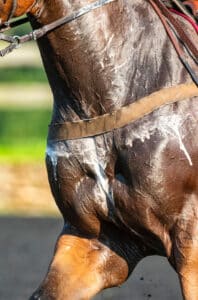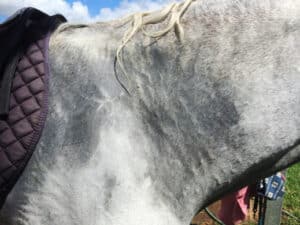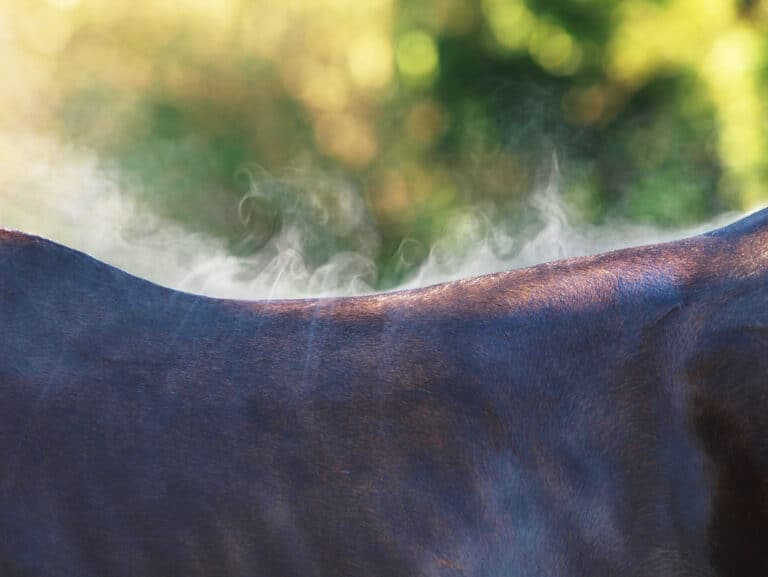Heat Stress: a serious health threat
This summer is shaping up to be a warm one, so your horse will need a little extra care, writes equine nutritionist LARISSA BILSTON.
Keeping and riding horses through summer requires an understanding of how to minimise heat stress and manage electrolyte balance. Working horses during very hot and/or humid weather can be potentially dangerous (even fatal) for both horse and rider, who both rely heavily on their ability to sweat to cool their bodies during exercise.
Respiratory cooling (puffing or blowing) also helps animals cool down but horses and humans rely less on this method of cooling than dogs, who cool by panting. Cooling by sweating and respiration is effective when humidity is low and a breeze is present. Hot, humid, still weather conditions make it much harder for the body’s core temperature to cool back down to a safe level.
Symptoms of heat stress include excessive sweating, lethargy, rapid, heavy breathing, high and/or erratic heart rate, salivation and redness of the mouth/tongue, muscle spasms, stumbling, uncoordinated gait and collapse. The skin may feel hot and dry, and a pinch test will indicate if dehydration is also present.

Treatment for heat stress
The normal rectal temperature of a horse lies in the range 37.0 to 38.0°C. Once this temperature exceeds 40°C the horse should be cooled down. If the core body temperature becomes too high (42°C) the horse will suffer from heat stress (hyperthermia).
Heat stress is a veterinary emergency. As quickly as possible pour cold (or iced) water over the entire body including the head, neck, belly and inner legs where large blood vessels are close to the surface.
As a matter of urgency:
- Call your vet for assistance
- Continue hosing with cold water
- Move the horse into the shade
- Provide a breeze or fans to assist cooling
- Offer small amounts of cool drinking water frequently.
Prevention of heat stress
Many official equestrian sporting organisations around the world now use the Wet Bulb Globe Temperature (WBGT) Index or a Heat Index to decide whether competitions should be run, or cancelled due to the risk of overheating horses and riders.
As individuals riding at home it is important to make sensible decisions about how much work to safely subject horses to during hot, humid weather.
When a horse must be worked during very hot weather, try to ride during the coolest and least humid part of the day and reduce the length and intensity of the training.
It is important to provide shade and preferably a breeze (this can be supplied by a fan) for horses in their paddocks, yards or stables during very hot and especially hot, humid weather. Shade and hosing with a breeze or fan during recovery from exercise helps to reduce core temperatures quickly.

Antioxidants reduce impact of heat stress
Strenuous exercise and hot environmental conditions are two major factors causing oxidative stress in animals.
Oxidative stress occurs when free radicals (reactive oxygen species) outnumber the antioxidant levels in the body, causing cellular and muscle damage, fatigue and decreased performance.
Supplementing with additional antioxidants such as organic selenium, organic chromium, vitamins C and E, carotenoids and enzymes such as superoxide dismutase (SOD) during very hot weather or heavy exercise can reduce the risk of oxidative stress.
Research in intensively farmed animals including poultry, pigs and dairy cattle shows measurable improvements in animal welfare, growth rate, milk production, meat and egg quality in response to supplementation with antioxidants.
Horse-specific research has demonstrated synergistic benefits from the combined antioxidant action of SOD-rich freeze-dried melon pulp, vitamin E and organic selenium. By measuring muscle enzyme levels, scientists were able to demonstrate that exercising horses resulted in significantly less muscle damage after they were fed the antioxidant combination.
The study concluded that the antioxidant blend was able to restore and maintain cell membrane integrity in muscle cells thereby improving the horse’s resistance to physical training.
Managing electrolyte balance
Daily salt requirements
Horses require between seven and 12 grams of plain salt per 100 kilograms of bodyweight every day. This is the amount required for maintenance: even more is needed for sweat replacement on very hot days and following heavy exercise.
Since salt is usually added to pellets and grain mixes designed for horses, this salt must be counted in calculations of how much extra to add. Top up with plain salt (sodium chloride) which can be purchased as table salt, pool salt, flossy salt or stock salt. Free access to a container of clean, loose salt rather than a salt block is also advisable because many horses will not lick a block for long enough to meet their salt requirements.

Sweat replacement
Sweating horses can lose as much as 10 to 15 litres of fluid per hour. Dehydration occurs if this liquid is not replaced. However, it is not as simple as just adding water.
The fluid in an animal’s body contains various salts called electrolytes (sodium, chloride, potassium, calcium) which help manage the hydration of individual cells and blood volume. The water and electrolytes lost in sweat will be gradually replaced over the course of a few days rest as the horse drinks water and eats a diet with the correct mineral balance.
You can make a simple electrolyte blend that provides the major electrolyte salts lost in sweat. Add 45g plain table salt (sodium chloride) and 45g of lite salt (potassium chloride/sodium chloride) to 10 litres of water. Apple juice can be added to improve palatability. This will replace the sodium, potassium and chloride lost in approximately 9 litres of sweat.
However, a faster recovery is often desirable for horses who work every day, are living in hot and humid environments, or are competing over a number of days. These horses will benefit from a well formulated commercial electrolyte supplement.
There are various electrolyte supplements on the market containing the major electrolyte salts (sodium, chloride and potassium) as well as the electrolytes that are lost in smaller quantities (calcium and magnesium). They may also include amino acids and vitamins to aid recovery, and sweeteners to improve palatability. A quality electrolyte supplement should not contain more than 20 per cent sweeteners or fillers.
Electrolytes can be bought in a powdered form to be added to the feed, as a paste or gel to be given over the tongue, or as a liquid to be mixed with water for an electrolyte drink. Horses usually have to be ‘trained’ to drink electrolytes, so if planning to use them at a competition, make sure your horse is familiar with the taste in the weeks beforehand.
Always make fresh clean water available to a horse after sweating. Do not offer electrolyte-enhanced water without providing access to plain water.
It is important to feed just the right amount of electrolyte salts because giving too much or too little can actually increase dehydration. Optimise the health of your horse this summer with a combination of electrolytes, antioxidants and avoiding hard work during hot and humid weather.
Larissa Bilston, BAgrSc (Hons) is the Equine Nutritionist for Farmalogic.



